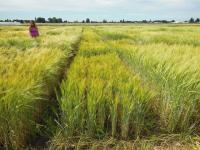About
 Organic growers need new crops, markets, and rotation options supported by varieties that are developed specifically for organic conditions. The long-term goal of this NIFA-OREI funded research project is to provide organic gardeners, growers, processors, and consumers with an alternative crop, food, and raw material that will be economically rewarding and sustainable. In this project we will test available naked (hull-less) varieties and germplasm and create a framework for breeding the next generation of varieties with a modest level of beta-glucan that will meet FDA guidelines for soluble fiber in human diets, and also be suitable for feed use and brewing.
Organic growers need new crops, markets, and rotation options supported by varieties that are developed specifically for organic conditions. The long-term goal of this NIFA-OREI funded research project is to provide organic gardeners, growers, processors, and consumers with an alternative crop, food, and raw material that will be economically rewarding and sustainable. In this project we will test available naked (hull-less) varieties and germplasm and create a framework for breeding the next generation of varieties with a modest level of beta-glucan that will meet FDA guidelines for soluble fiber in human diets, and also be suitable for feed use and brewing.
Development, assessment, and participatory breeding of naked multi-use barley will be conducted in five representative regions: Pacific Northwest (OR, WA), Upper Midwest (MN, WI) and North East (NY). Three classes of germplasm will be used:
- a composite targeted to K-12 students and gardeners
- a large diversity panel to apply genetic data to improve barley for organic systems
- a multi-regional trial to identify varieties for release.
We will assess germplasm under organic conditions in school and home gardens, university research stations, and on-farm trials. We will evaluate agronomic, food, feed, malting, and brewing performance. Workshops will educate stakeholders on best management practices and processing procedures. We will quantify the economic and environmental benefits of organic naked barley production and products. Our outreach efforts will familiarize students, gardeners, growers, processors, and consumers with the benefits of naked barley varieties and provide guidance for capitalizing on the advantages these varieties can offer. Read the 2017 project narrative here.
In 2020, a second NIFA OREI project was funded: Developing Multi-use Naked Barley for Organic Farming Systems II.
The long-term goals are to:
- provide organic growers, processors, and consumers with a new crop, food, and raw material alternative that will be economically rewarding and sustainable
- identify and release high-yielding, high-quality, flavorful and nutritious multi-use naked barley varieties for organic systems based on a regional variety testing program anchored in Oregon, California, Wisconsin, Minnesota, and New York;
- characterize traits that were identified in the first iteration of this project as being especially critical for organic production on a large, genetically diverse panel of naked barley germplasm;
- create a modified nested association mapping (NAM) population to breed for traits important for organic production and regionally relevant to the different areas represented in this project and to maximize the efficiency of selection via integration of phenotypic and genotypic data
- observe, analyze, and report the results of natural selection and artificial selection on an organically grown naked barley composite population – a vehicle for engaging K-12 students and home gardeners in organic grains and foods; (6) educate the public on the uses and production value of naked barley using a number of dissemination techniques.
Critical needs described by organic farmers at field days, through personal communication, during the planning grant meeting, and through survey results include:
- high yielding naked barley varieties with defined multi-use quality profiles;
- varieties with superior weed competitiveness and resistance to diseases;
- improved communication between farmers, processors, distributors and end-users.
Critical needs of food and malt beverage manufacturers include full characterization of flavor, nutrition, quality and functionality. Critical needs of barley processors, wholesalers, and retailers focus on the need for reliable sources of domestic, organic, high-quality barley for multiple end-uses. Currently, organic barley end-uses and markets are stratified due to the presence of the adhering hull and they could be further stratified if naked food barleys are selected for the highest possible grain β-glucan. Varieties intended for malting/brewing have hulls - due to predominant brewing equipment - and should have low to moderate grain β-glucan. Some brewers could use mash filters and/or blends of malt from both hull adhering and naked barley. However, the hull precludes direct food use and is not an advantage in feeds. Therefore, our approach is to focus on breeding naked barley with moderate grain β-glucan for all three uses.
Follow us on Instagram at https://www.instagram.com/nakedbarley/
Follow us on Facebook at https://www.facebook.com/multibarley/
Funding

This project was funded in 2017 by the NIFA Organic Research and Extension Initiative grant, part of the USDA National Institute of Food and Agriculture: Grant number 2017-51300-26809. In 2020, a second grant, Developing Multi-Use Naked Barley for Organic Systems II was awarded funding: Grant number 2020-51300-32179. In 2023, a third grant was awarded funding: Grant number 2023-51300-40964.

